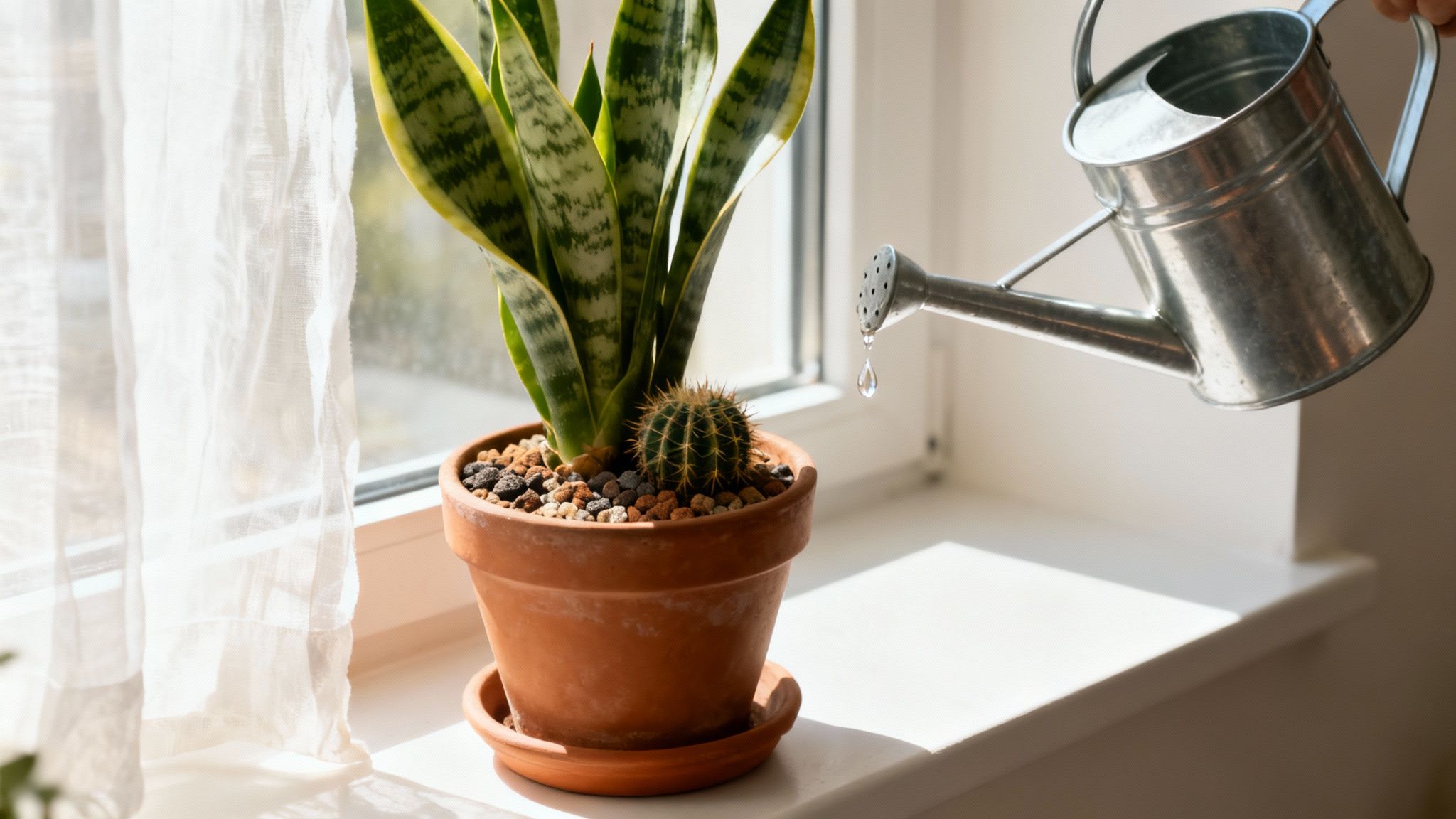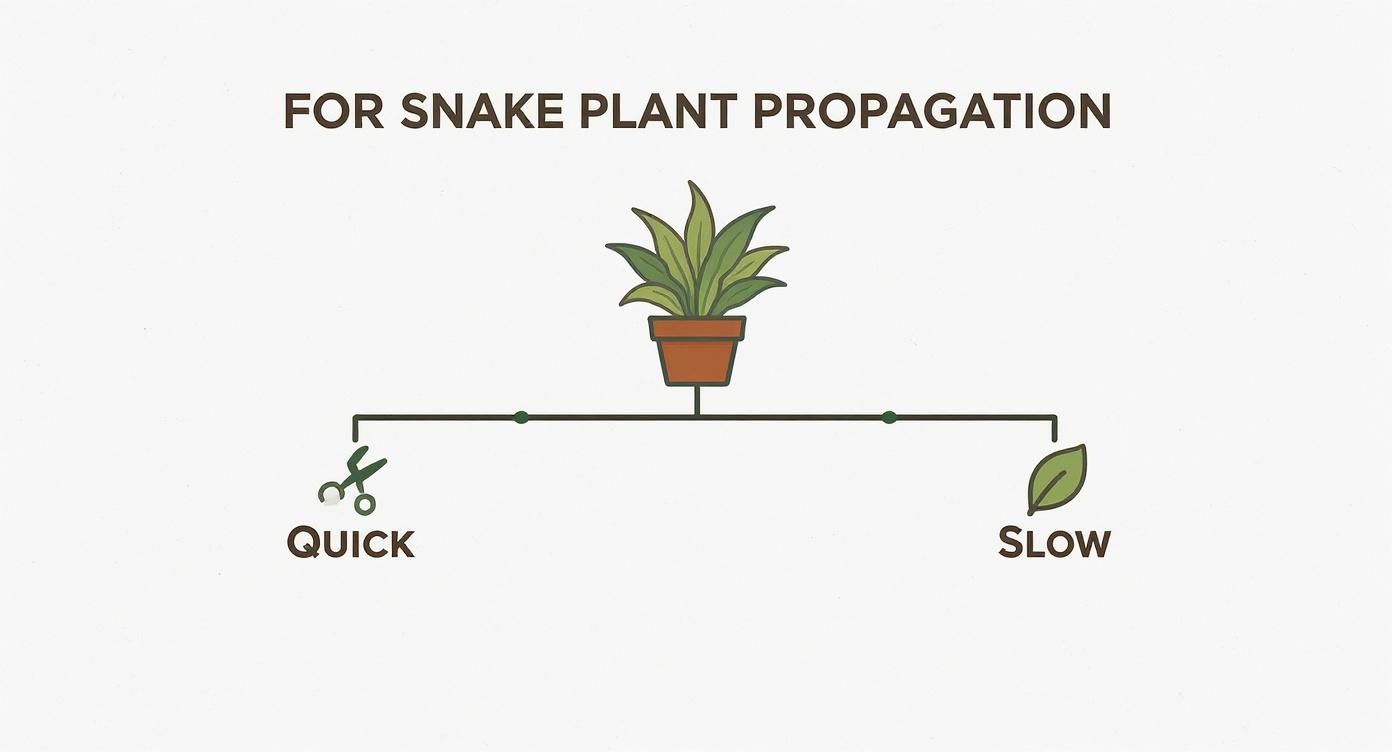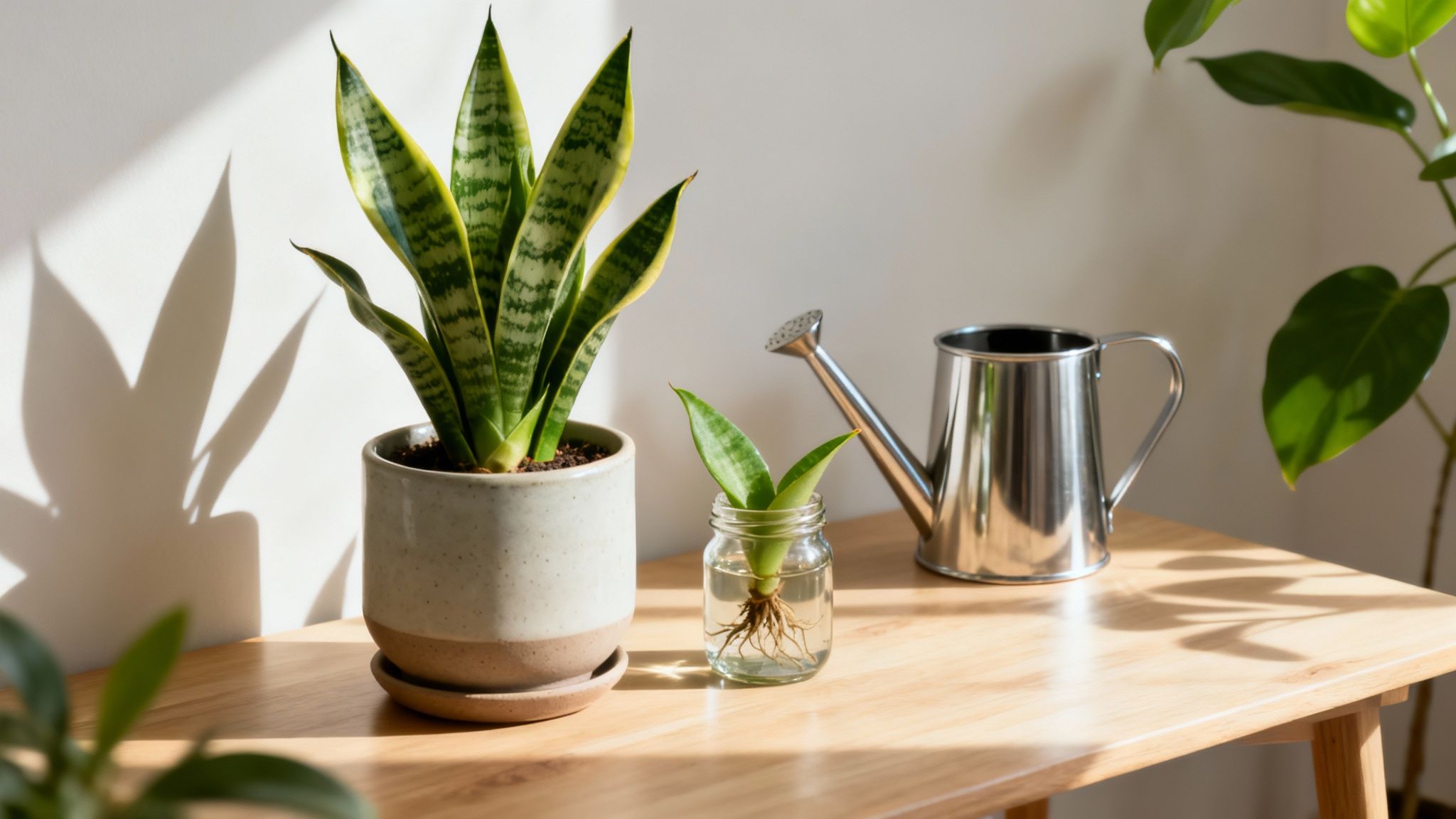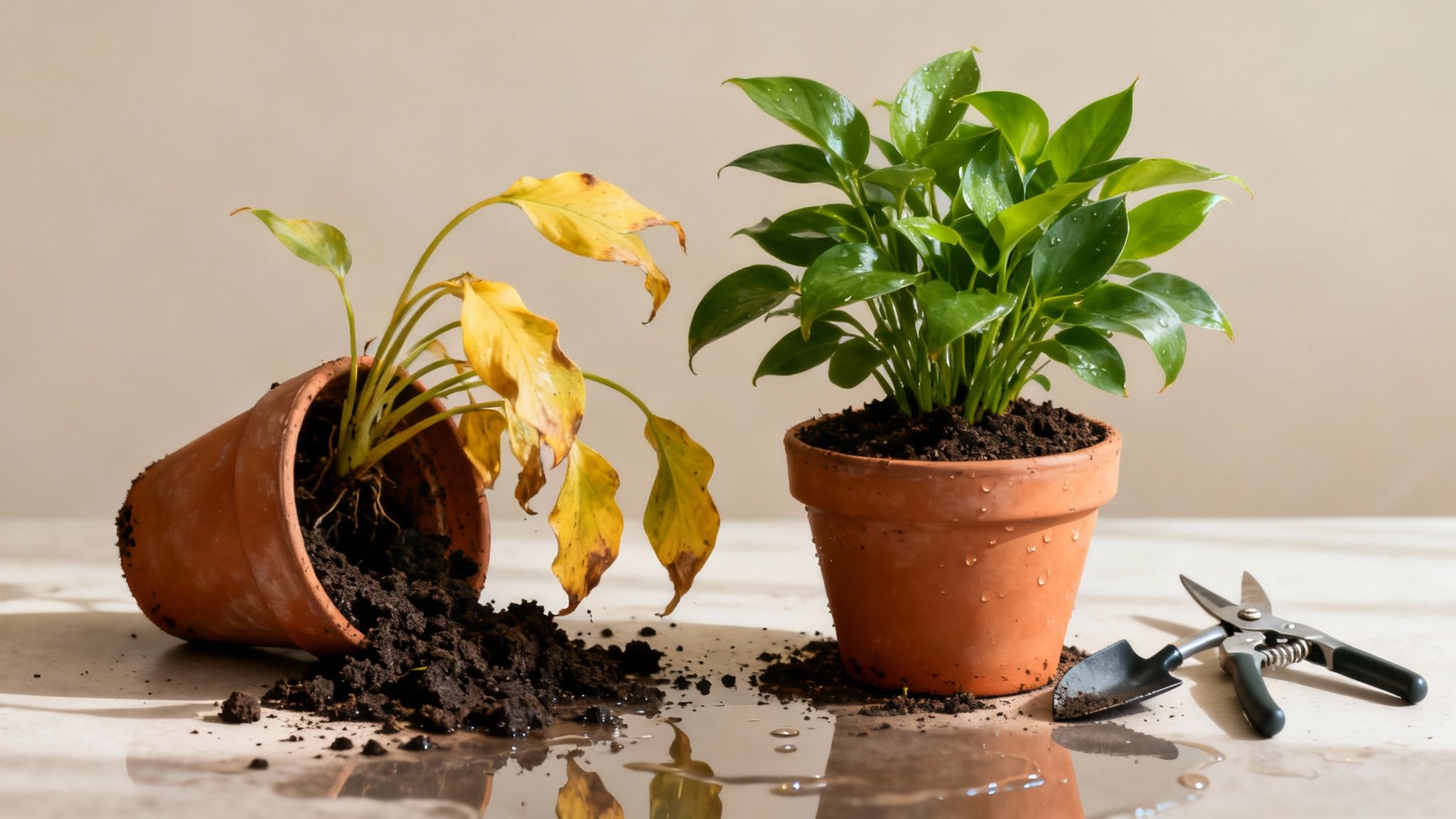Have you ever brought home a beautiful snake plant, only to watch its vibrant leaves turn a sad, mushy yellow? You're not alone. When it comes to snake plant care, the secret to success is refreshingly simple, but one common mistake—overwatering—can quickly undo all your good intentions. The good news? This guide will show you exactly how to avoid that pitfall and help this tough, stylish houseplant thrive.
Welcome to the definitive guide for the snake plant, Dracaena trifasciata (formerly Sansevieria trifasciata), a true icon in the world of indoor gardening. You might know it as Mother-in-Law's Tongue, and it's celebrated everywhere for its striking, architectural leaves and nearly indestructible nature. Beyond just looking good, it's a powerhouse air purifier, quietly working to make your space healthier.
This guide is your one-stop shop for everything you need to know. We'll cover all the bases:
Nailing the perfect lighting and watering routine
Turning one plant into many with simple propagation
Decoding common problems like those dreaded yellowing leaves
We'll also show you how the Tendra app can become your personal plant care assistant. Imagine getting a smart reminder right when your snake plant is thirsty or using our AI to diagnose a problem in seconds. If you're still getting the hang of identifying your green friends, you might want to check out how a plant identification app can transform your growing. Let’s get started and make sure your snake plant doesn't just survive—it absolutely thrives.
Building the Perfect Environment for Your Snake Plant
Getting the environment right is the secret to spectacular snake plant care. Yes, Dracaena trifasciata is famously tough, but giving it the right conditions means it will stop just surviving and start truly thriving. Let's break down the three pillars of its world: light, water, and soil.

Unlocking Growth with the Right Light
Light is your plant's food. It’s true that snake plants can put up with low-light corners, but that's a survival tactic, not their preference. In dim spots, growth will crawl to a halt, and the striking patterns on the leaves might start to fade.
To see your snake plant flourish, give it bright, indirect light. A spot near an east-facing window with its gentle morning sun is the gold standard. South- or west-facing windows also work beautifully, just be sure to place the plant a few feet back from the glass. You want to avoid those harsh, direct rays that can literally scorch the leaves.
This incredible tolerance for less-than-ideal lighting is exactly why snake plants are so popular. They are a huge part of the 'low light plants' market, which happens to be the biggest slice of the global indoor plant pie. As more of us live in city apartments and work in offices where sunlight is a luxury, the snake plant has become a go-to green companion. You can dig into more trends on the indoor plant market over at Mordor Intelligence.
Practical Tip #1: Rotate your snake plant every few weeks to ensure all sides get even light exposure, preventing it from leaning towards the window.
The Art of Watering a Succulent
If there’s one surefire way to kill a snake plant, it’s with kindness—specifically, too much water. These plants are succulents that evolved in the arid regions of West Africa, storing water in their leaves for dry spells. They are built to handle drought, not floods.
The golden rule for watering a snake plant is simple: when in doubt, don't. Their roots are incredibly prone to rot in soggy soil, which is hands-down the number one killer of these otherwise indestructible plants.
Your new watering mantra is the "soak and dry" method. When the soil is completely dry, give it a thorough drink until water runs out of the drainage holes. Then, and this is the important part, leave it alone. Don't even think about watering it again until the soil has dried out all the way to the bottom of the pot. In most homes, this translates to watering every 2-6 weeks in the summer and even less often—maybe once a month—in the winter.
Creating the Perfect Soil Foundation
The final piece of the puzzle is the soil. Since snake plants are so susceptible to root rot, the right potting medium isn't just a suggestion; it's non-negotiable. Standard potting soil is a death sentence, as it holds onto way too much moisture for far too long.
Your goal is to use a soil mix that provides fantastic aeration and drainage. The easiest path to success is a pre-bagged cactus or succulent mix from any garden center. It's specifically designed to dry out fast. Feeling like a DIY pro? You can whip up your own perfect blend with this simple recipe:
Two parts standard potting soil
One part perlite or pumice (for airflow)
One part coarse sand or fine orchid bark (for drainage)
This mix creates a structure that lets the roots breathe and prevents water from sticking around. If you want to get really nerdy about it, you can explore our guide to mastering soil pH for a deeper dive.
Advanced Snake Plant Care: From Surviving to Thriving
Once your snake plant is settled in and happy, you can start thinking beyond basic survival. It's time to shift gears from just keeping it alive to helping it thrive. For a mature snake plant, this really boils down to three things: repotting, feeding, and the occasional trim.
To Repot or Not to Repot
Here’s a little secret most plants won't tell you: snake plants actually enjoy a bit of a tight squeeze. They do their best work when they're slightly root-bound, meaning their roots have pretty much filled up the pot. This little bit of stress can actually trigger them to send out new baby shoots, or "pups." You’ll probably only need to repot your snake plant every 2-5 years. Keep an eye out for these tell-tale signs that it's time:
You can see roots making a break for it out of the drainage holes.
The plastic pot is literally bulging or getting warped from the pressure inside.
Water zips right through the pot without seeming to soak in.
When you do repot, resist the urge to go big. Pick a new pot that’s only 1-2 inches (2.5-5 cm) wider in diameter. This gives the roots just enough fresh real estate to grow into without leaving them swimming in a sea of soggy soil.
Practical Tip #2: Schedule your repotting for spring or early summer. This is when the plant is in its active growth phase, so it'll bounce back from the shock of being moved much faster.
Feeding Your Snake Plant a Healthy Diet
Snake plants are incredibly self-sufficient, but that doesn't mean they don't appreciate a little snack now and then. Think of fertilizer as a seasonal vitamin boost, not a three-course meal.
Get the Right Stuff: A standard, all-purpose liquid houseplant fertilizer with a balanced formula like 10-10-10 is perfect.
Dilute, Dilute, Dilute: This is key. Always mix your fertilizer to half-strength.
Timing is Everything: Only feed them during the spring and summer growing season, once every 4-6 weeks.
Never Feed a Thirsty Plant: Always water your plant a day or so before you plan to fertilize to avoid scorching the roots.
Once fall rolls around, put the fertilizer away. The plant is heading into dormancy and simply doesn’t need the extra nutrients.
Pruning for Health and Aesthetics
For snake plants, pruning is more about housekeeping—keeping the plant looking sharp and healthy. Grab a clean, sharp knife or a pair of scissors. You can snip off an entire damaged or yellowing leaf by cutting it right at the soil line. This helps the plant focus its energy on growing new, healthy leaves. Don't toss those healthy cuttings! They're perfect for propagation.
How to Propagate Snake Plants and Share Your Success
One of the best parts of owning a snake plant is realizing just how easy it is to make more of them. It’s not just a free way to fill your home with more greenery; it's a chance to share a piece of your indoor jungle.
Propagation is the heart and soul of the houseplant community. In fact, a surprising statistic shows that as many as 80% of houseplant enthusiasts prefer to propagate their plants. This simple act of sharing is a huge reason why the snake plant is so popular. You can find more cool stats on this trend over at Zipdo.co.
Method 1: Propagation by Division
If you want the quickest path to a new, full-looking snake plant, division is your best friend. This technique is all about separating the "pups"—the new shoots that pop up from the main plant's underground root system. The ideal time to do this is spring or summer.
Gently Unpot: Carefully slide the whole plant out of its pot.
Expose the Roots: Shake off the loose soil to see the root system.
Find Your Sections: Look for individual pups that already have a decent set of roots.
Make the Cut: Using a clean, sharp knife, gently separate the sections.
Pot Up Your New Plants: Settle each new division into its own pot with fresh, well-draining cactus mix.
Method 2: Propagation by Leaf Cuttings
Growing a new plant from a leaf cutting is a slower, more magical process.
Select a Leaf: Pick a healthy, mature leaf from your plant.
Make Your Cuts: With a clean knife, slice the leaf into sections at least 2-3 inches (5-7.5 cm) long. Remember which end is the "bottom."
Place in Water or Soil: You can stand the cutting in a jar with about an inch of water (changing it weekly) or plant it directly in moist soil after letting the cut end callous over for a day or two.
Wait and Watch: Roots can take a few weeks to several months to appear. Patience is key!
An Important Note on Variegated Varieties: If you're propagating a variegated snake plant like 'Laurentii' (the classic one with yellow edges) using the leaf cutting method, the new plants will almost always revert to solid green. To keep those beautiful yellow edges, you have to use the division method.
Troubleshooting Common Snake Plant Problems
Even a plant as tough as the snake plant can hit a rough patch. Most of the time, these issues are simple to fix. The golden rule: most snake plant problems lead back to water.
Problem-Solution: Decoding Yellow Leaves
The Problem: You notice a once-vibrant leaf has turned a sad, washed-out yellow and feels soft to the touch.
The Likely Culprit: Overwatering is the prime suspect 90% of the time. When the soil never dries out, the roots suffocate and rot, cutting off the plant's ability to pull up nutrients.
The Solution: Put down the watering can. Immediately. Stick your finger a good 2-3 inches (5-7.5 cm) into the soil. If you feel any moisture, walk away. Let that soil dry out completely. If the base of the plant feels squishy, you may need to unpot it, trim away any black, mushy roots, and repot in fresh, dry soil. For a closer look at what yellow leaves can mean, check out our guide to decoding your plant’s signals.
 care" />
care" />
Brown Tips and Wrinkled Leaves
While giving too much water is the most common killer, giving too little can cause its own set of problems, though they’re usually less fatal.
Brown, Crispy Tips: This often signals the plant has gone bone dry for too long or a buildup of minerals from tap water.
Wrinkled or Curling Leaves: A truly thirsty snake plant will start dipping into the water reserves stored in its leaves, causing them to look a bit deflated.
The fix is straightforward: give the plant a deep drink until water flows from the drainage holes. The leaves should plump back up in a day or two.
Practical Tip #3: To avoid mineral buildup, try using filtered, distilled, or rainwater for your snake plant.
If you’re ever truly stumped by a strange spot or a symptom you can't identify, Tendra's AI disease diagnosis feature is a game-changer. Just snap a photo of the problem area, and our AI can help pinpoint the issue and give you a clear, step-by-step treatment plan.
Getting to Know the Snake Plant Family
When someone says "snake plant," you probably picture the classic tall, blade-like leaves with bright yellow edges. That's the iconic Dracaena trifasciata 'Laurentii', but it's just the opening act for a surprisingly diverse group.
It's no surprise these plants are everywhere. Market reports show that over 55% of U.S. consumers specifically look for air-purifying plants. With good snake plant care, they can live for over 20 years, becoming a real fixture in your home. If you're curious about the numbers, you can dive deeper with this in-depth industry research.
A few other standouts have become go-to favorites:
Dracaena trifasciata 'Zeylanica': A sophisticated look with deep green leaves marked with wavy, silvery-green stripes.
Dracaena trifasciata 'Hahnii' (Bird's Nest): A compact, dwarf variety that grows in a tight rosette and rarely gets taller than 6 inches (15 cm).
Dracaena angolensis (Sansevieria cylindrica): A total showstopper with smooth, round, spear-like leaves that shoot straight up from the soil.
Dracaena trifasciata 'Moonshine': Elegant and almost ethereal, the 'Moonshine' stands out with its pale, silvery-green leaves that almost seem to glow.
Real-World Application: Sarah's Snake Plant Rescue
Let's look at a real scenario. Sarah from Portland, a new plant parent, was thrilled with her Dracaena trifasciata 'Moonshine'. Wanting to be a good plant mom, she watered it every Sunday, just like her other houseplants. A month later, she noticed the beautiful silvery leaves were turning yellow and the base felt soft. Frustrated, she thought the plant was a lost cause.
Instead of giving up, Sarah turned to the Tendra community. She posted a photo and described her care routine. Within minutes, experienced gardeners chimed in, identifying the classic signs of overwatering and root rot. Following their advice, she unpotted the plant, carefully trimmed the mushy, dark roots, and repotted it in a fresh, dry cactus mix. She held off on watering for two weeks. Slowly but surely, her 'Moonshine' stabilized and even pushed out a new, healthy leaf. This is where connecting with other growers becomes invaluable—turning a potential plant tragedy into a learning success story.
From Novice to Pro with Tendra
Mastering snake plant care is incredibly rewarding. By providing the right balance of bright, indirect light, letting the soil dry out completely between waterings, and using a well-draining mix, you set your plant up for decades of healthy growth. Remember that most problems, especially yellowing leaves, trace back to overwatering. Learning to propagate through division or cuttings allows you to expand your collection and share the joy with others.
These tips are just the beginning. Imagine having a community of gardeners like Sarah's right in your pocket. That's the power of Tendra. When you’re facing a new plant challenge or want to share a recent success, the community is there. Connect with local gardeners who've solved this exact problem—discover Tendra, where gardeners connect, grow, and share.







